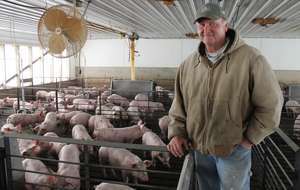American Meat vs. American Agriculture
MUSINGS OF A MIDWEST PIG FARMER
by Larry Sailer
Feb. 21, 2012
With less than 2% of the world’s population engaged in production agriculture, farmers shoulder a lot of responsibility to feed a growing world. It’s been said repeatedly that we’ll have to double crop yields by 2030 in order to meet food/feed demand. Population growth and rising incomes are driving increased demand for high-value animal protein, as well. That’s why it continues to amaze – and perplex – me how and why people continue to criticize food production and pit consumer against farmer and even farmer against farmer. It seems the definition of “sustainable agriculture” has become convoluted.
The complexity of this issue really hit home for melate last week when I stepped into a classroom at CAL (Coulter-Alexander-Latimer) High School in rural Franklin County, Iowa. CAL, like many other schools nationwide, showed a screening of the Graham Meriwether’s documentary entitled American Meat. This film criticizes many modern production practices and encourages farmers to raise livestock on pasture rather than inside buildings.
“There’s no reason for a confinement house in the country, in the word, anywhere!” says Joel Salatin of Virginia in American Meat. As someone who’s been engaged in farming for 50 years, I can think of several reasons for raising livestock in buildings. For starters, let’s consider the Midwest’s climate and weather patterns. The average temperature of an Iowa winter is about 34 degrees, and often the mercury dips below the freezing point. How comfortable is it for pigs to root through snowdrifts during a freezing, cold Iowa winter?
My family raised pigs outside for a number of years, and in doing so,we experienced more problems with disease, pests and weather. Because of Iowa’s weather patterns, we farrowed outdoors in spring and fall. The majority of pigs were raised this way, so the worst market prices were whenthe porksupply was the largest in the fall and in the spring. Moving our pigs inside allowed us to farrow year roundand recognize better market prices. Indoor hog operations also allow us to raise a leaner, more consistent product that was driven mainly by consumers. During the 1980s, there was a public perception that chicken was healthier than pork. Today’s pork is actually leaner than chicken, and because of this, our hogs don’t have enough natural insulation (i.e. fat) to handle inclement weather. Lean genetics were bred primarily into hardy Large White pigs, but this breed also gets sunburn and is better suited for indoor environments.
“We know pigs are ‘happier’ in warm, dry buildings,” writes Missouri hog farmer Blake Hurst in his Feb. 19 editorial to the New York Times. Hurst’s editorial refutes the Chipotle restaurant’s recent ad campaign saying the company uses only “happy pigs.” The day after the Grammy Awards, during which Chipotle’s ad first aired, McDonald’s announced it would require its pork suppliers to end the use of gestation crates. While crates restrict a sow’s movements, they also serve their purpose. Gestation stalls ensure sows get the nutrition they need to produce healthy piglets. Otherwise, sows fight for feed. The stronger, more aggressive sows get the most food and often get too fat. The more timid sows are often undernourished during the gestationperiod, which can result in underdeveloped offspring.
[youtube]http://www.youtube.com/watch?v=vbdB9WOICyo&feature=player_embedded[/youtube]
I love opportunities to talk with consumers about how we raise pork and why. In fact, I did just that today. Earlier today I was the guest speaker for the Morning Exchange Club of Waterloo (similar to Lions, Rotary and Kiwanis). They got to know me, an Iowa hog farmer. And they had an opportunity to get their questions answered.
“Know your farmer” is a statement made in the American Meat documentary. And it’s a statement I can agree with… in my own context! Americans have the privilege of living in the “land of the free.” This means we all have the freedom to choose. It also means that we operate under a free market economy. So, let the market place determine what foods get produced and how they are produced. Farmers’ markets and the local foods movement have their place as do larger scale operations. There’s enough demand – and enough need – for all farmers.
